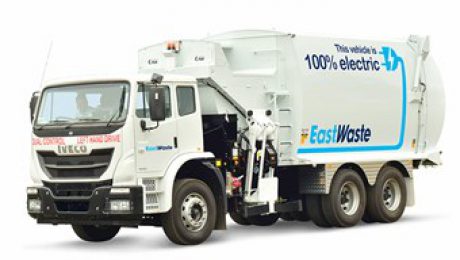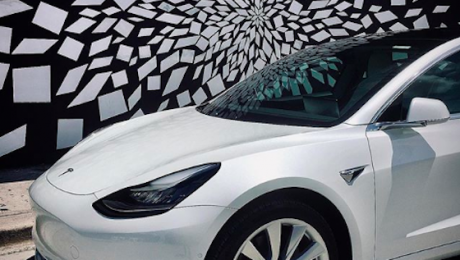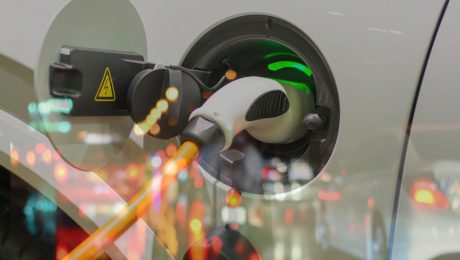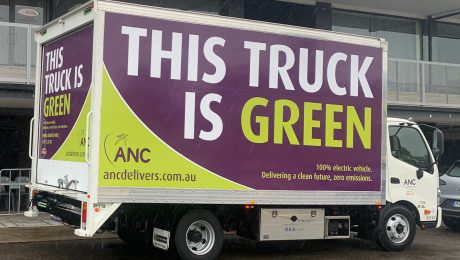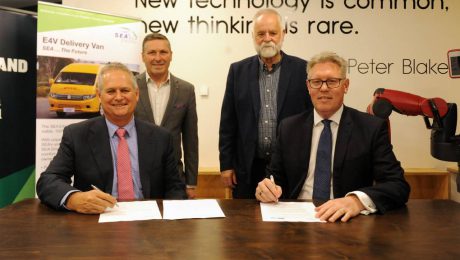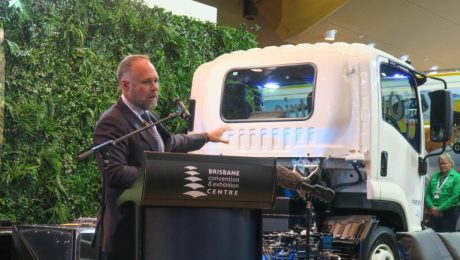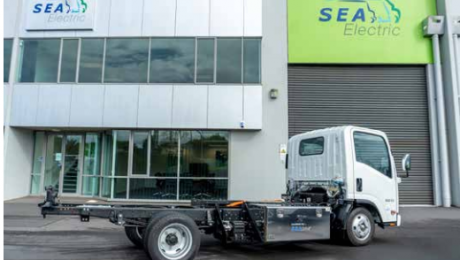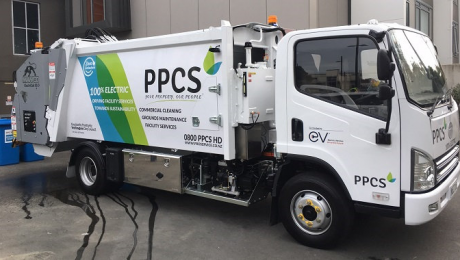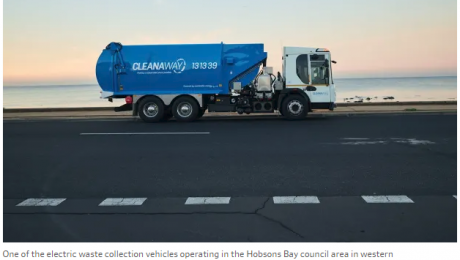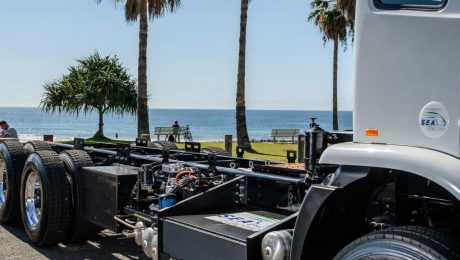First Electric Waste Collection Truck for South Australia
East Waste sees range of cost savings in EV move
Adelaide waste and resource manager East Waste will in December commission South Australia’s first fully electric-powered waste collection truck.
The move fulfills the promise of a policy initiative that began 18 months ago that also looked at CNG.
East Waste chairman Brian Cunningham says the new truck will replace a diesel-powered truck and, with zero emissions, “remove from our suburban streets the polluting equivalent of 20 vehicles generating 63 tonnes of carbon dioxide every year”.
The truck is the first in a fleet replacement program and is supplied by Superior Pak, using SEA Electric drivetrain technology and an Iveco chassis.
It is valued around $550,000, which is about $150,000 more than a diesel version.
East Waste believes the extra investment will return financial savings along with a raft of environmental benefits.
Read how East Waste came to drive down the EV path, here
“This is much more than a terrific environmental initiative by East Waste,” Cunningham says.
“It will create financial gain to better manage the cost of kerbside collections of recyclable resources and waste.
“We conservatively project that our new electric truck will save in excess of $220,000 over the seven-year life of a diesel truck.
“Even with the additional $150,000 purchase price, that is a $70,000 nett saving.”
East Waste argues that cost savings will be even greater:
- if, as expected, diesel prices continue to climb
- with significantly fewer moving parts than a conventional engine, the new truck is likely to last longer than the seven years of conventional trucks.
- maintenance will be reduced by at least two-thirds.
- the truck’s drivetrain generates electricity each time it reduces speed, returning charge to the batteries and reducing wear and tear; especially to brake pads.
“Residents in suburban streets will fall in love with our new truck without realising it,” Cunningham says.
“With reduced air pollution comes the removal of noise pollution as the truck travels from house to house on bin collection day. It is silent.”
East Waste will install a 30kW solar system at its Ottaway depot to provide renewable energy to charge the truck’s batteries every day.
“We are confident that electric technology can transform the East Waste fleet,” East Waste CEO Rob Gregory tells ATN.
“Advances in battery technology may, in coming years, enable us to replace our entire fleet of 40 trucks.
“East Waste replaces its trucks at a rate of about five a year.
“We cannot, at this stage, say how many of our fleet might ultimately be electric.
“With respect to CNG, East Waste continuously considers and reviews for its fleet and activities the application of new technologies and innovation. CNG is in that mix.”
East Waste is a subsidiary of seven metropolitan Adelaide councils; the cities of Burnside, Campbelltown, Mitcham, Norwood, Payneham & St Peters and Prospect, the Town of Walkerville and the Adelaide Hills Council. READ MORE
By: Rob McKay, Australasian Transport News – fullyloaded.com.au, 21.08.2019
- Published in Media Release, News, SEA-Drive, Technology
Total cost of ownership: Tesla Model 3 compared with Audi A5 and Toyota Camry
To regular readers of this column, it will be no surprise that Tesla’s Model 3 is cheaper on a total cost of ownership basis than competing luxury sedans from BMW and Mercedes, but a Toyota Camry? Model 3 is a state-of-the-art electric vehicle with a 5-star safety rating and a driving experience that’s gotten rave reviews from every auto mag under the sun. Is it possible that it’s even in the same price class as the entry-level, reliable-but-dull Camry?
That’s the surprising conclusion of Loup Ventures, a tech-oriented venture capital firm, which performed a five-year comparative cost of ownership study. Loup first compared the two vehicles in 2017, and concluded that Model 3, which had a purchase price about 40% higher than that of the Toyota Camry LE, would end up costing 13% more to own and operate over five years. Considering that Model 3 includes Autopilot capability, over-the-air updates and a host of other features that you won’t find on the Camry (or any other Toyota), the Tesla still sounded like a pretty good deal.
Now Loup has updated its comparison. Using 2019 figures, the new study reached the astonishing conclusion that, when all relevant factors are taken into account, Model 3, which is indisputably a superior car, is slightly cheaper to own and operate over a five-year period than Toyota’s mass-market sedan.
When it comes to the purchase price (which, unfortunately, is the only number many car buyers will look at), the Camry still wins hands down. In fact, the price gap has widened to 59% since 2017 – the cheapest Model 3 you can order online is $38,990 (a $35k version is theoretically available by special order), whereas the Camry LE starts at $24,600.
However, when you consider the other costs of ownership, some big differences become apparent. Surprisingly, Loup found typical insurance costs for a Model 3 to be slightly lower than for a Camry – and the gap is expected to widen over the next few years as Tesla’s in-house insurance products become available (the program has already launched in Australia and China, and is expected to come to North America this year).
Costs for fuel and maintenance are far lower for any EV, compared to a legacy vehicle – Loup projects that Model 3 owners will save almost six grand on fuel and $2,800 on maintenance over five years, compared to Camry drivers.
However, it’s the comparative resale values of the two cars that closes the deal for the Tesla. As even a brief perusal of the pre-owned vehicles on sale will show, Teslas retain their value extremely well. Loup estimates that, after five years, the Model 3 will still be worth almost $19,000, whereas the Camry will fetch only $9,000. When the resale values of the two vehicles are included in the calculation, the cost per mile for a Model 3 comes out to $0.46, compared to $0.49 for the Camry LE.
That’s a pretty jaw-dropping conclusion, considering that we’re basically comparing a luxury, high-tech apple to a basic, low-budget orange. How does Model 3’s TCO compare to other sedans that are supposedly in its class? Loup also ran the figures for an Audi A5, and the result is…embarrassing? Game-changing? Adjectives fail us. The cost per mile of the German sedan over five years comes out to $0.80, a little less than double that of Model 3. READ MORE
Article by Charles Morris, EVANNEX, August 13 2019
Written by: Charles Morris; Source: Loup Ventures; Video: Like Tesla
- Published in Media Release, News, SEA-Drive, Technology
SEA Electric appoint Regional Director for North America
Experienced clean transport industry executive David Brosky recently joined the SEA Electric team as Regional Director for North America.
Mr. Brosky brings over 30 years’ experience in business development, sales, marketing, and program management for leading global automotive and commercial vehicle equipment and systems suppliers, including TI Automotive, Dana Corporation and Bosch Rexroth Corporation. In the last 15 years, David has held senior-level positions in the Clean Transportation sector focusing on hybrid and electric powertrain solutions for commercial vehicles. Most recently as Vice President – Sales with Lightning Systems, a hybrid, and electric powertrain systems supplier.
With SEA Electric recently penetrating the North American market, Mr. Brosky’s industry experience coupled with his passion for business and clean energy will be a great asset to SEA Electric.
SEA Electric is excited to welcome Mr. Brosky and look forward to this new generation of change.
David Brosky, Bachelor of Science- Business Administration, Lawrence Technological University, Southfield, Michigan USA
About SEA Electric
SEA Electric is an Australian automotive technology company that locally develops and assembles 100% electric-powered vans, commuter busses, and light/medium duty rigid truck models using its proprietary SEA-Drive® power-systems. Additionally, the company works closely with a selection of leading American truck companies and brands including Ford, Isuzu, and Chevrolet to engineer and locally assemble SEA Electric power-systems to their models.
SEA Electric head office operates from a facility in Melbourne with plans underway for a large-scale assembly facility in the Latrobe Valley in regional Victoria.
Article by Lindsay Gilbert & Jacque May, SEA Electric, 15th July 2019
For further information, please contact:
Tony Fairweather, President – SEA Electric LLC
T: +1 310 284 3180
M: +1 (830) 281 0464
E: tony@sea-electric.com
- Published in Media Release, News, SEA-Drive, Technology
Australians encouraged to transition to EVs
The Clean Energy Finance Corp (CEFC) held the NSW Electric Vehicle Drive Day on July 4, to encourage Australians to switch to electrical vehicles (EVs).
CEFC CEO, Ian Learmonth, said that fleet buyers could play an important role in helping Australia tackle one of its toughest emissions challenges – transport.
“Australia has some 19,000 businesses operating fleets with 20 vehicles or more, representing more than 2.1 million vehicles in total.
“Australians have traditionally been early adopters of new technology, but we have fallen behind the pack when it comes to EVs.
“Fleets buyers purchase as many as one in five new vehicles in Australia. We want to see EVs become their fleet vehicle of choice. It’s about using their market power to influence the way we use our roads and the impact we have on our environment.”
Australia is the world’s 16th largest car market but ranks 21st in terms of new EVs sold, according to the 2019 EV Outlook from Bloomberg New Energy Finance. While there are about 9100 EVs in Australia, this is 25 per cent lower than the much smaller New Zealand market.
“The reality is that we need to cut emissions right across our economy, from electricity to transport and more. Australians are already acting on electricity, with more and more of us putting solar PV on our rooftops,” Mr Learmonth said.
“We can also have a big impact on emissions if we put electric vehicles in our garages, supported by charging infrastructure.
“In a smaller market like Australia, we know it will take time for more EV models to become available, and for prices to come down so EVs are more affordable for personal buyers. For fleet buyers, where driving needs are different, there is an opportunity for the EV transition to occur more quickly.”
Cars and light duty vehicles were responsible for 75 per cent of Australia’s total transport emissions of 102 million tonnes in 2018, according to the National Greenhouse Gas Inventory. The data also shows that transport was the equal fastest growing sector for emissions (along with fugitive emissions) from 2000 to 2018, with continued growth expected to 2030.
Modelling produced for the CEFC and ARENA found that with the right combination of incentives, models and infrastructure, EV sales in Australia could surge from as early as 2021. The Energeia report forecast that EVs could represent 90 per cent of all cars and light commercial vehicles by 2050, supported by $1.7 billion in investment in new public-access fast charging points.
The NSW EV Drive Day gave fleet buyers the chance to test the driving experience and performance of a range of vehicles and discuss vehicle operating considerations with manufacturers and industry experts.
It showcased the latest range of battery EVs, plug in hybrids and hydrogen fuel cell EVs, across 16 models and 21 vehicles. More than 100 registered fleet managers and buyers met with representatives from BMW, Hyundai, Jaguar, KIA, Mini, Mitsubishi, Nissan, Renault, SEA Electric, Tesla and Toyota.
“Increasing the share of EVs on the road translates directly into lower emissions from fuel combustion. While EV charging will add to demand for electricity, emissions from vehicle charging will fall as we increase our share of renewables,” Mr Learmonth said.
“By working with industry groups and other financiers, it’s clear that vehicle buyers want to see lower vehicle costs and more models to encourage them to switch to EVs.
“We hope that increased buyer interest in EVs from volume buyers such as fleet owners can encourage EV manufacturers to grow their share of the Australian market.”
The CEFC has financed more than 1000 EVs via its co-finance programs with major banks and non-bank lenders. Together with its finance for lower emissions on-farm vehicles and equipment, the CEFC has invested more than $500 million in low emissions transport. The CEFC is also considering investments in EV charging infrastructure.
The NSW EV Drive Day was organised by the CEFC, with support from Transport for NSW, the NRMA, the Australasian Fleet Management Association, Charge Together and JetCharge/Charge Fox. READ MORE
Article by India Murphy, Energy Magazine, July 5 2019
- Published in Media Release, News, SEA-Drive, Technology
CEFC encourages fleet owners to super charge Australia’s transition to electric vehicles
The roar of motorsport at Sydney’s Eastern Creek speedway will be replaced by whisper quiet electric vehicles (EVs) today when fleet buyers test drive one of the largest selections of EVs assembled in Australia.
The NSW Electric Vehicle Drive Day, led by the CEFC, is a chance to show fleet buyers why sales of EVs are gaining momentum around the world and encourage them to use their market influence to super charge Australia’s switch to EVs.
CEFC CEO Ian Learmonth said that fleet buyers could play an important role in helping Australia tackle one of its toughest emissions challenges – transport. Australia has some 19,000 businesses operating fleets with 20 vehicles or more, representing more than 2.1 million vehicles in total.
“Australians have traditionally been early adopters of new technology, but we have fallen behind the pack when it comes to EVs,” Mr Learmonth said. “Fleets buyers purchase as many as one in five new vehicles in Australia. We want to see EVs become their fleet vehicle of choice. It’s about using their market power to influence the way we use our roads and the impact we have on our environment.”
Australia is the world’s 16th largest car market but ranks 21st in terms of new EVs sold, according to the 2019 EV Outlook from Bloomberg New Energy Finance. While there are about 9,100 EVs in Australia, this is 25 per cent lower than the much smaller New Zealand market.
Mr Learmonth added: “The reality is that we need to cut emissions right across our economy, from electricity to transport and more. Australians are already acting on electricity, with more and more of us putting solar PV on our rooftops. We can also have a big impact on emissions if we put electric vehicles in our garages, supported by charging infrastructure.
“In a smaller market like Australia, we know it will take time for more EV models to become available, and for prices to come down so EVs are more affordable for personal buyers. For fleet buyers, where driving needs are different, there is an opportunity for the EV transition to occur more quickly.”
Cars and light duty vehicles were responsible for 75 per cent of Australia’s total transport emissions of102 million tonnes in 2018, according to the National Greenhouse Gas Inventory. The data also shows that transport was the equal fastest growing sector for emissions (along with fugitive emissions) from 2000 to 2018, with continued growth expected to 2030.
Modelling produced for the CEFC and ARENA found that – with the right combination of incentives, models and infrastructure – EV sales in Australia could surge from as early as 2021. The Energeia report forecast that EVs could represent 90 per cent of all cars and light commercial vehicles by 2050, supported by $1.7 billion in investment in new public-access fast charging points.
The NSW EV Drive Day gives fleet buyers the chance to test the driving experience and performance of a range of vehicles and discuss vehicle operating considerations with manufacturers and industry experts.
It will showcase the latest range of battery EVs, plug in hybrids and hydrogen fuel cell EVs, across 16 models and 21 vehicles. More than 100 registered fleet managers and buyers will meet representatives from BMW, Hyundai, Jaguar, KIA, Mini, Mitsubishi, Nissan, Renault, SEA Electric, Tesla and Toyota.
Highlights include:
- − Toyota iRoad, a unique 3-wheeled, 2-seater EV (view here)
- − Remote self-parking fuel cell Hyundai (view here)
- − Woolworths electric delivery truck, built by Australia’s SEA Electric (View here)
- − Charging station demonstration by Jet Charge/Charge Fox
Mr Learmonth added: “Increasing the share of EVs on the road translates directly into lower emissions from fuel combustion. While EV charging will add to demand for electricity, emissions from vehicle charging will fall as we increase our share of renewables. By working with industry groups andother financiers, it’s clear that vehicle buyers want to see lower vehicle costs and more models to encourage them to switch to EVs. We hope that increased buyer interest in EVs from volume buyerssuch as fleet owners can encourage EV manufacturers to grow their share of the Australian market.”
The CEFC has financed more than 1,000 EVs via its co-finance programs with major banks and non- bank lenders. Together with its finance for lower emissions on-farm vehicles and equipment, the CEFC has invested more than $500 million in low emissions transport. The CEFC is also considering investments in EV charging infrastructure.
Through the Clean Energy Innovation Fund, the CEFC has also invested in two Australian companies at the forefront of the EV transition:
- − Relectrify is developing and commercialising control technology that unlocks extra performance in battery systems by boosting their second-life storage capability and lifespan once they are no longer effective as EV batteries.
− SEA Electric is converting medium-duty trucks and commercial vans into EVs, integrating and assembling EV drive train systems into a basic chassis and framework including the cab, fitted with the battery pack, electric motor, and other elements of the drive train.
The NSW EV Drive Day is organised by the CEFC, with support from Transport for NSW, the NRMA, the Australasian Fleet Management Association, Charge Together and JetCharge/Charge Fox. READ MORE
Article courtesy of PV Magazine Australia, July 4 2019
- Published in Media Release, News, SEA-Drive, Technology
SEA Electric and TAFE Gippsland Sign Training Agreement
Training agreement for electric vehicles
The Latrobe Valley is one-step closer to a new electric vehicle factory with the signing of a memorandum of understanding between manufacturers SEA and TAFE Gippsland on Friday.
The MOU formalises an agreement to collaborate developing new curriculum and delivering training for workers interested in the EV industry.
“We want to upskill people in the Latrobe Valley to have a fully-prepared workforce for when we commission this facility in 2021,” Mr Cameron said.
The Latrobe Valley Authority is working with SEA and Latrobe City Council to find an appropriate site for the facility, which is due to be under construction in 2020 and begin operations in 2021.
Photo from left to right – SEA Electric’s Regional Director Mark Cameron, the Latrobe Valley Authority’s Andrew Waller, Mayor Graeme Middlemiss and TAFE Gippsland Chief Executive Grant Radford sign the memorandum of understanding. READ MORE
photograph Hayley Mills
Article by Michelle Slater, Latrobe Valley Express, 1st July 2019
- Published in Media Release, News, SEA-Drive, Technology
SEA Electric Trucks Feature at Brisbane Truck Show with Reo, Foton and Tatra
Electric Trucks, the Reo and Foton, plus Tatra
There was plenty to see at the Brisbane Truck Show this year including electric trucks, the Reo and Foton, plus Tatra.
After making a number of successful deals in the US, SEA Electric was back on home turf at the BTS showing off its 100 per cent electric vehicles including a garbage compactor, as well as an Isuzu display model, demonstrating the driveline components in the engine bay and between the chassis rails. More of SEA Electric’s work could be found at the Isuzu stand further down the hall, as part of the company’s collaboration with Isuzu in Australia.
SEA Electric may have been one of the first entities to show electric trucks here in Australia, but this time around was joined by several others drivetrains using electricity as a power source, dotted around a number of exhibits. This included Dana, who have entered a licensing agreement with SEA, but also Fuso, Cummins, Meritor.
The number of displays including the electric power theme reflects the high level of interest in electric power in the trucking community and should enable technology developers to invest further in the new driveline options.
The Foton trucks introduced to the market earlier this year made their first appearance at BTS since the company relaunched as a factory-owned importer of Chinese trucks.
Tatra has been long known as an importer of heavy duty all wheel drive trucks with an innovative chassis design developed to enable the heavy duty trucks to access any ground conditions. The brand has recently moved to using cabins sourced from the Paccar organisation, DAF cabins. The next stage in the company’s development will be to introduce some lighter models aimed at more general applications where all wheel drive is necessary in different industries around Australia.
After being unveiled at last year’s Megatrans exhibition in Melbourne, the Diamond Reo truck range appeared in its reincarnated form at the BTS for the first time. Ivan Vodanovich was assembling Diamond Reo trucks in Melbourne in the 80s and has now been involved in reviving the brand based on the China-sourced SAIC truck range.
Four examples were on display at this year’s BTS an 8×4 rigid and a 6×4 prime mover using the same shape as the models displayed in 2018. The novelties were a new a prime mover, which bears an uncanny resemblance to the MAN cabins of the past, and there was also a smaller 4×2 model, set up as a local delivery truck on display.
Article featured by Diesel Magazine, 27th June 2019, http://www.dieselnews.com.au/electric-trucks-the-reo-and-foton-plus-tatra/
- Published in Media Release, News, SEA-Drive, Technology
Kiwi-Build for EV Trucks
EV Talk NZ interview Stephen Fairweather, our NZ General Manager, about electric trucks being assembled in New Zealand by SEA Electric.
“Kiwi-Build for EV Trucks”, pg 11 & 12 of EV Talk June 2019 READ MORE
Electric trucks are being assembled in New Zealand. Moreover, they have been successful on the road for some time. Absorb that for a moment. In fairness, they are being finished in New Zealand,
under the auspices of an Australian company, with batteries from China and motors from Canada. Still, trucks that would otherwise be spewing diesel fumes on our road are instead silently
getting around on electricity.
The trucks, and soon to come vans, are the work of Melbourne-based SEA Electric. The company has quickly developed a strong reputation for developing electric-propulsion drivetrains for a range of common truck platforms – to the point where they developed Isuzu Australia’s electric truck concepts.
General manager for SEA Electric New Zealand, Stephen Fairweather, is now leading the expansion of the brand within New Zealand – where it is finding a ready market.
“We have got a lot of vehicles in the pipeline at the moment,” Fairweather explains. “Currently there are seven vehicles already on the road. Four of them were locally built in Auckland. Others being built are all sorts for various markets.”
Councils are finding electric propulsion to be a boon for the relatively short, stop-start trips that kind of vehicle endures. The locally assembled ones were put together by body-builder Manco Environmental at its East Tamaki facility. All up a further 18 vehicles are in the pipeline, including a prominent, EECA-backed contract with Countdown for their home delivery trucks.
“They have got five coming,” Fairweather says. “We built the first one in Melbourne to make sure all the engineering was right and then shipped that over here. CAL Isuzu is building the other
four in Hamilton.”
CAL Isuzu is building several vehicles for SEA, part of how it prefers to work with truck brands here. Rather than its own factory, it works with partners already set up with workshops to handle the conversions. CAL is handling Isuzu product in the North Island, while Blackwells will handle it in the South Island – the latter building some units for Foodstuffs.
The vehicles arrive in New Zealand with their diesel drivetrain intact. It is removed from the truck and taken into parts stock by the dealer. Not that Isuzu is the only brand they will work
with. There are also IVECO and Hino trucks with SEA drivetrains installed on the road here. “Our system’s designed to fit into a standard rigid chassis. So we don’t mind what brand of truck it is,” Fairweather explains.
For operators, that means they can stick with a supplier and chassis they are comfortable with, speeding integration into fleets.
The vehicles are very configurable, with batteries that range from 70kWh to 216kWh on offer. SEA’s battery density has been growing over time, providing more range with no additional bulk and little extra weight. Systems are modular, with Fairweather explaining one customer is in the process of up-sizing their battery, their existing unit able to be sold to a new customer at a reduced rate.
A similar build model will be taken with the arrival of their electric delivery and minibus vans. They are based on a Chinese van that looks similar but is not the same as, the outgoing generation Hiace. Action Manufacturing will handle the drivetrain fitment to the “glider” bodies. The four-tonne van will retail for $89,990 and the 15-seat minibus for $99,990. A number are already on order, three going to Alsco to handle laundry and another to Sanford to carry chilled fish. The latter will use a chiller powered off the traction battery, making it entirely electric.
So how far will a SEA Electric unit go? That depends on the size of the vehicle and the configuration the user chooses. The small delivery trucks will go 200-260km on a charge, and the rubbish trucks a similar distance – though with the addition of a considerable number of uplifts of bins. The vans hit up to 350km. Ranges like that take the vehicles beyond simple “last mile” status, with Fairweather explaining one client is working to have an electric truck do a Rotorua to Taupo return trip in the morning, then Rotorua to Tauranga in the afternoon. Moreover, that is without DC fast charging.
SEA has not yet equipped its vehicles for the technology, working instead on the basis that its commercial clients will have, or can fit, 32 amp three-phase charging, allowing for overnight fills or top-ups between jobs.
“We end up with probably the biggest charging infrastructure in the world, actually,” Fairweather explains. “Because just about every commercial environment’s got a 32 amp PDL 56 series
screwed to the wall.”
Charging is relatively fast, and so is payback. For a medium-size electric delivery truck, Fairweather says payback on the additional investment comes in around two-and-ahalf years. The savings are not just from fuel. Service costs are lower, particularly brakes. With the large rubbish trucks, four brake changes were scheduled a year – the electric version only required one. “And according to them, it didn’t really need doing; they just took the wheels off to have a look to see what was going on and decide of they’d change them while they were at it.” impact on tyre use – around 15-20%.
“That one we weren’t quite expecting,” Fairweather says. “We think it is because of the linear nature of the motor – rather than the horrible diesel whack on them.”
Smooth operator We got the chance to go for a ride around Otahuhu in one of Sea Electric’s Isuzu NLRbased small trucks, this one headed for a life delivering groceries for Countdown. With its electric drivetrain well behind you, the SEA truck is even quieter than the other electric commercial we have experienced, the LDV EV80. Without the weight of a body behind us, there was
some jiggle to the way the truck rode, but otherwise, it was very smooth – taking off the power delivery curve appears to have been programmed to perfection. The Isuzu demonstrates
one of those critical reasons such conversions work so well. There is nothing in the cab of this truck that gives away the game as to what it is – other than the silence. It is just a truck, with all
the convenience and comfort levels Isuzu’s experience have given it. Even the transmission shifter is the same.
- Published in News, SEA-Drive, Technology
Wellington welcomes its first electric rubbish truck with SEA Electric.
Wellington’s first fully electric rubbish truck will join two electric vans in servicing about 40 Wellington City Council social housing sites.
The Manco SEA EV10 Electricat was revealed at a ceremony at the council’s Berkley Dallard apartments on June 12.
Bought with the aid of a government low emission vehicles contestable fund administered by the Energy Efficiency and Conservation Authority (EECA), the e-truck goes to contractor Professional Property & Cleaning Services (PPCS).
The same company introduced two electric vans last year and has ordered six more EVs.
PPCS committed to introducing EVs where possible in taking up a contract for cleaning and rubbish removal at WCC’s Parks, Sports and Recreation and City Housing sites.
“We see this new truck as a major step towards our target of converting 70% of our fleet to electric or hybrid by 2025,” PPCS general manager Sarel Bloem says.
“We’re a family owned New Zealand company and we’re passionate about protecting the environment. That’s why we bought this truck and why we’ve just ordered an additional six electric vehicles. This means in the next few months 100% of the vehicles we use to service Wellington will be electric.”
Wellington mayor Justin Lester says the city has been installing EV chargers for residents’ use but needs to lead by example.
“That’s why we’re converting our own fleet to electric and I’m delighted that PPCS are joining us in this. This is about making our city cleaner for us and future generations.”
Climate change portfolio holder councillor David Lee says Wellington is continuing the journey to becoming a zero-carbon capital by 2050.
“We will only get there with help from companies like PPCS getting on board. I’d encourage other companies with large fleets to do the same.”
Climate Change minister James Shaw says it is important for New Zealand’s service fleet to convert to EVs.
“Unlike private vehicles, rubbish trucks, taxis and delivery vehicles are on the road most of the working day,” he says.
“The more of them that are electric the quicker we will be able to reach our emission reducing goals.”
The Manco SEA EV10 Electricat is based on a SEA Electric (NZ) SEA Drive system with the rest built by Auckland-based Manco Environmental.
Similar electric trucks are run by Civic Contractors in Auckland which has 200 vehicles it aims to switch to electric by 2025, and the Palmerston North City Council.
The trucks have a 120kW battery pack and 180km range and are recharged at their depots.
Article by Geoff Dobson, Transport Talk NZ, June 12 2019
- Published in Media Release, News, SEA-Drive, Technology
Cleanaway sees good signs from electric rubbish trucks
The chief executive of waste management group Cleanaway says a pioneering trial of electric rubbish trucks in a council area in Melbourne is showing promising signs in its early stages.
The electric trucks have a range of 180 kilometres before they need to be recharged and the first has been operating for the past few weeks in the City of Hobsons Bay, which covers 12 suburbs in western Melbourne.
Cleanaway chief executive Vik Bansal said there were good signs on the operating costs for the vehicles for kerbside collections, because they needed to be kept low for the new technology to be viable in the long term.
“At this stage, the trials are progressing well but it is a bit too early to fully gauge their success,” Mr Bansal said on Tuesday.
“So far the electric trucks are showing positive signs in terms of their cost to operate and overall reliability.”
Jonathan Marsden, mayor of the City of Hobsons Bay council area that encompasses 88,000 people and suburbs such as Williamstown, Altona and Newport, said it was only a small part of the overall fleet of rubbish collection vehicles, but the council wanted to be a leader in this sector.
“It’s early days obviously, and I think as battery technology improves they will be able to carry even greater payloads,” Mr Marsden said.
Local residents were curious about whether the electric vehicles would be coming to collect their own household rubbish.
“It’s a small part of a very big fleet,” he said.
Range and noise
The vehicles were assembled in Bundaberg in Queensland under a collaboration with SEA Electric and Superior Park.
The vehicles have a range of between 180 kilometres to 200 kilometres before they require recharging, and the drive system is able to generate electricity when braking.
They are also much quieter than regular waste collection vehicles, which has local governments across Australia eyeing the potential to cut road noise for early morning collections and keep the vehicles off the road in peak-hour traffic in congested areas.
Mr Bansal said there was a lot of opportunity to advance this type of technology. The company was also closely monitoring the costs and service levels to make sure it was a viable option over the long term.
Delivering a consistent and reliable service was fundamental to Cleanaway, and the trial needed to prove there wasn’t a significant increase in waste collection costs for ratepayers.
Cleanaway operates about 5000 waste collection vehicles around Australia.
Other local council areas in Geelong and Moonee Valley are also scheduled to be part of trials with the electric rubbish trucks so that Cleanaway can test them in different settings with hills and unique local characteristics. READ MORE
Article by Simon Evans, Senior Reporter – Financial Review, June 11 2019

- Published in Media Release, News, SEA-Drive, Technology
SEA Electric is successfully penetrating the European market
Leading electrical systems for trucks and other commercial vehicles.
Concern for nature and the environment is becoming increasingly important in purchasing decisions. Similarly, they are also considering SEA Electric, an Australian company that has expanded almost everywhere in the world over two years with its electric batteries for trucks and vans.
Australia’s leading software and technology company, SEA Electric, is finally entering the European market with its carefully developed and advanced electrical system. After successful breakthroughs on the domestic and New Zealand market, several months ago, they successfully launched their business in America, and now they open their premises in Vienna.
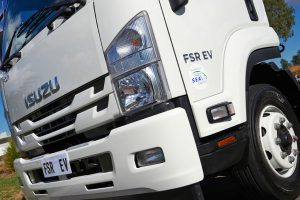
An investment for a cleaner and cheaper future
At a time when industry is increasingly aware of environmental pollution and wants to contribute to cleaner air, it offers unique technology for commercial and delivery vehicles. Seven different SEA-DRIVE® power-system innovative systems have been developed to replace diesel engines from smaller and larger commercial vehicles, from vans to trucks (55,000lb). The system with electric batteries operates on the basis of patented computer technology. Their engines are used by important international companies around the world.
Cooperation signed with Ikea and DHL
In Australia, SEA Electric has already entered into strong European companies such as DHL and Ikea, and the first European licensing cooperation has already been signed with the largest German manufacturer of garbage trucks. For vans and municipal transport services, such as mail and garbage collection, they have developed advanced propulsion technology with the highest energy efficiency and easy and convenient charging. A number of junction points in cities also help to save energy, as stopping and firing the battery is full (regenerative braking). Electrically propelled electric cars and vans represent a green solution for cities that are confronted with traffic congestion or are seeking to improve people’s lives.
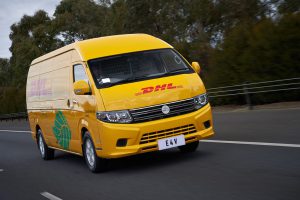
Easy filling on the road or in the base
The SEA-DRIVE® electric battery system is fully charged within 4-6 hours and is therefore perfect for commercial and delivery vehicles from major European cities, which are still small enough for delivery at a distance of up to 350 km. And they are overly concerned about where to fill up the vehicle quickly while driving. Unlike other electric vehicles, all SEA- Drive® systems have the option of charging with a portable 22kW charger in any 3-phase socket. They are therefore an ideal solution for delivery in urban areas where the vehicle returns to the base and the battery can be fully charged overnight.
For a green environment without harmful releases
Tony Fairweather, executive director of SEA Electric believes that the system of effective urban e-mobility will also adopt European cities and thus contribute to solving environmental congestion. “SEA Electric is the ideal solution for cities that are consciously and consciously prepared for environmental zones. It will be prohibited to use harmful emissions vehicles, which is why it is right for ministries and municipalities to become aware as soon as possible of the importance of using electric batteries, engines. Research suggests that vehicles fossil fuels will disappear from cities by 2050, and the use of electric trucks should increase by 2025. ”
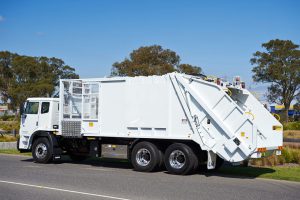
Easy to install and upgrade the system
The growing demand for nature-friendly transport, government support for the purchase of electric cars and improved filling infrastructure open up new opportunities for environmental and high-tech technological advances. SEA Electric Energy Technology, due to efficient and easy installation procedures, enables the upgrading and development of the hardware of each embedded subsystem. There is no doubt that SEA Electric has a technology and a business model that meets the requirements of the transition to the electrical system since they have a complete package for almost every commercial vehicle.
https://avto.over.net/clanek/sea-electric-uspesno-prodira-na-evropski-trg/
“SEA Electric is successfully penetrating the European market” by Anja Kovacic, Market Development Manager – EU at SEA Electric, 28th May 2019
- Published in Media Release, News, SEA-Drive, Technology

